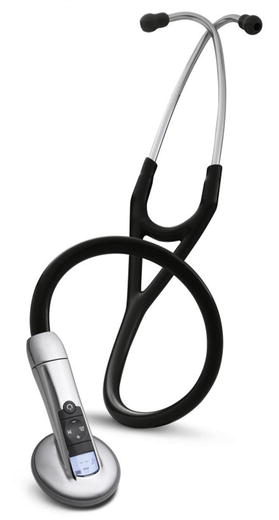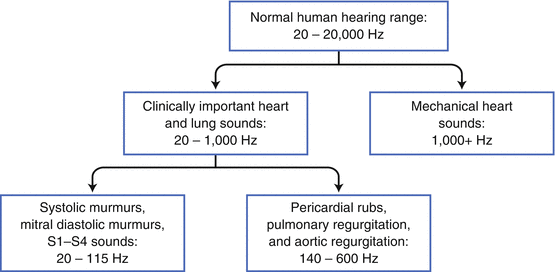Fig. 3.1
Acoustic stethoscope
The chest piece.
The bell is used for low frequency sounds.
The diaphragm is used for high frequency sounds.
Some chest pieces act as both the bell and diaphragm, with pressure determining function.
The tube transmits the sound from the chest piece to the ear pieces.
Earpieces.
A variety exist for the comfort of the wearer.
Should always face forward.
Sound and Physiologic Frequencies (Fig. 3.2)
Sound is the oscillation of pressure through a medium, such as air. The frequency of a sound wave is perceived as pitch, and the amplitudes at intensity or loudness [1].
The average normal hearing range of a person is 20–20,000 Hz [1].
The range of clinically important heart and lung sounds is 20–1000 Hz [2]. Systolic murmurs, mitral diastolic murmurs, and S1 – S4 sounds range from 20 to 115 Hz, pericardial rubs, pulmonary regurgitation, and aortic regurgitation range from 140 to 600 Hz [2], while mechanical heart sounds are heard at ranges over 1000 Hz [3].
In the clinic and scientific literature, cardiac sounds are commonly characterized using ambiguous terms such as “low” and “high” frequency.
Characteristics of the Ideal Acoustic Stethoscope
Largest ear tips possible for a good seal in the external auditory canal.
Adjustable angled metal headpiece.
Internally smooth double vinyl tubing.
Shorter tubing provides less sound loss in transmission.
Separate bell and diaphragm.
Large diameter bell for low frequencies.
Smooth, stiff, and thin diaphragm for high frequencies.
Physical Factors Affecting Sound Transmission
From the patient’s body surface to the earpiece, factors influencing sound transmission include [2]:
Thickness of clothing worn by patient [4].
Pressure and degree of mechanical contact on the body surface by the chest piece.
Size and volume of bell.
Surface hardness of the bell cavity.
Diaphragm thickness, size, and tautness.
Inside diameter of the tube.
Rigidity, length, and interior surface smoothness of the tube.
Acoustical characteristics of the human ear.
Air leaks between components, such as chest piece and body surface or at the ears.
Ambient noise limiting auscultation [5].
Selection of an Acoustic Stethoscope
In 1940, a study found that medical professionals choose stethoscopes not based on the acoustic properties of the instrument, but rather on the basis of exterior finish and features, as well as on the recommendation of mentors and peers [2]. This seems true even today.
Currently there is no gold standard or guideline in selecting a stethoscope. This is mainly due to limited data. Furthermore, the little evidence available suggests differences may be subtle [2], with unknown clinical relevance.
Comparisons Between Acoustic Stethoscopes
One study by Iversen et al. compared the clinical performances of a high cost advanced stethoscope to a low cost basic stethoscope [6].
They used the 3MTM Littmann® Master CardiologyTM stethoscope (3 M, Cerritos, CA, USA) (higher cost and advanced) and the 3MTM Littmann® Classic IITM SE stethoscope (3 M, Cerritos, CA, USA) (lower cost and basic).
The two stethoscopes were randomly distributed to 72 house officers without formal training in auscultation in 10 different hospitals. After using the stethoscopes for 4 weeks, participants examined 20 patients (16 with murmurs). Diagnostic accuracy was measure.
33 % of patients were diagnosed correctly with the simple scope, while 35 % were diagnosed correctly with the advanced stethoscope (no statistically significant difference).
The authors concluded that using a more advance and expensive stethoscope does not improve the rate of murmur detection and diagnosis made by house officers.
A limited number of articles in recent scientific literature have compared the acoustic properties of different brand stethoscopes [2, 7, 8].
One study [2] analyzed six stethoscopes including the Littmann® Classic IITM (3MTM, St. Paul, MN, USA), the Littmann® Cardiology IITM (3MTM, St Paul, MN, USA), the Littmann® MasterTM (3MTM, St. Paul, MN, USA), the Hewlett-Packard® Rappaport-SpragueTM (Hewlett-Packard®, Palo Alto, CA, USA), the Tycos® HarveyTM Triple Head (Welch Allyn®, Skaneateles Fall, NY, USA), and the Allen® Medical Series 5ATM (Allen®, Acton, MA, USA) (Table 3.1).
Table 3.1
Comparison of six different brand stethoscopes examined by Abella et al. The three diaphragms that amplified the low frequency sounds were all Littmann® (3M, Cerritos, CA, USA) stethoscopes
Bell – amplification
Bell – attenuation
Diaphragm – amplification
Diaphragm – attenuation
Low frequencies
6
–
3
3
High frequencies
–
6
–
6
The acoustic transfer function (ratio of sound pressure at the earpiece to sound pressure at the chest piece) was used to compare the stethoscopes.
At low frequencies (37.5–112.5 Hz), all six bell pieces amplified the sound. Only the three Littmann diaphragms, however, amplified the low frequency sounds. Relative lower performance was statistically significant for Tycos® HarveyTM Triple Head ribbed diaphragm, the Hewlett-Packard® small diaphragm, and the Allen® Medical Series 5ATM diaphragm.
At high frequencies (125–1000 Hz), all six bell pieces and diaphragms attenuated but did not amplify the sound. Of the diaphragms, attenuation by the Tycos® HarveyTH Triple Head ribbed diaphragm was statistically significantly lower.
The authors concluded the Littmann® Cardiology IITM had the best overall performance. Generally speaking, sound attenuation between stethoscopes was not significantly different.
Characteristics of Electronic Stethoscopes (Fig. 3.3)

Fig. 3.3
Example of Electronic Stethoscope: 3M™ Littmann® Electronic Stethoscope Model 3200 (Copyright © 3M Littman Stethoscopes, St. Paul, MN, USA. Used with permission)
The basic structure of an electronic stethoscope resembles a conventional stethoscope [3].
Head and chest piece.
Sound transducer.
Adjustable gain amplifier.
Frequency filters.
Mini-speaker.
Batteries.
Some models can be attached to an acoustic stethoscope, converting it into an electronic device [9].
The chest piece can be switched from a bell to a diaphragm without interruption in auscultation [10]. Certain models also have an automated mute mode to lessen impact noise [3].
Cardiac sounds are transmitted by a wire; therefore, there is no tubular noise or limit on length [3]. Older models may suffer from background electronic noise [3], although newer stethoscopes have the capabilities to filter electronic noise [10].
Users can choose whether to amplify all sounds or only certain frequencies, with the user controlling the volume [9, 10]. Ambient noise can be filtered (Littmann.com).< div class='tao-gold-member'>Only gold members can continue reading. Log In or Register to continue
Stay updated, free articles. Join our Telegram channel

Full access? Get Clinical Tree



